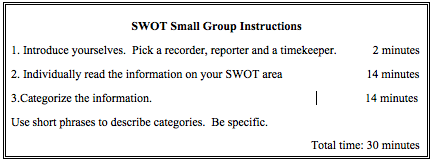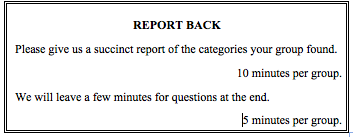“We want to set goals but we can’t agree how or where to focus our efforts. We all have our favorite areas, but there must be a better way. We need a method for gathering information so that we can get the most mileage for our efforts. What do you suggest?”
#18 SWOTs
What are SWOTs?
SWOTs help you gather information for strategic planning and other goal setting meetings. SWOT information (Strengths, Weaknesses, Opportunities, and Threats) provides data to accurately determine your group’s current performance. A group can mean any organization and/or team, unit, department, or division within that organization. SWOT information also provides a foundation for effectively and intelligently setting goals, priorities, and other key decisions for the group’s future.
Strengths and Weaknesses examine the internal environment of the group. Examples of the internal environment include: how effectively employee skills and other resources are being used, the effectiveness of technology and data management systems, levels of creativity and risk taking, approaches to competition, and how well the organization functions as a unit.
Opportunities and Threats focus on the external environment affecting the group. The external environment can include industry, competitor, economic, social, or political information. Additionally it could include potential changes in technology, products, markets, financing, raw materials, and labor, threats from new competition, bargaining power of suppliers and buyers, and customer expectations.
When to Use SWOTs
- When an organization, or group within an organization, wants feedback on its performance
- When your group wants to gather information before setting long and/or short term goals
How to Use SWOTs
Before the Meeting
1. Prepare for the SWOT analysis.
a. Define what information should be collected.
Some groups are very detailed in their analysis, and develop a long series of specific questions to explore. Others perform better with fewer specific questions. You, along with those participants selected to help plan your SWOT analysis, determine the best approach for your group.
Most groups simply ask four questions. What are our internal Strengths? What are our internal Weaknesses? What are our external Opportunities? What are our external Threats?
NOTE: Be sure to ask only open ended questions.
NOTE: There is a danger in asking very specific questions. Specifics can influence what is considered and can narrow the potential range of responses. On the other hand, an incomplete SWOT assessment can result in a false sense of security. Do as much in-depth investigation as is feasible for your group. SWOTs should be an annual event, and the next round can be more in-depth and sophisticated if necessary.
b. Determine who should be asked for SWOT information. Ask the group: “Which stakeholder groups should be included? What other sources of data should be included (financial, etc.)?
SWOT information is gathered by asking your stakeholders a series of questions. Stakeholders include all people who have a stake in the success of the group. These people include internal and external customers, employees from as many layers as feasible within the organization, managers at all levels, suppliers, stockholders, and lenders.
NOTE: It is critical that information be gathered from ALL stakeholders, not just from the group that will be analyzing the information in the meeting.
NOTE: Information on external Opportunities and Threats can also be obtained from journals, magazines, newsletters, trade shows, conventions, federal reports, and private research groups.
c. Decide how the SWOT analysis will be conducted.
SWOT questions are usually asked in face-to-face interviews or by questionnaire.
d. Determine roles, responsibilities and time frames for collecting SWOT data.
Agree on who will be responsible for contacting stakeholders, preparing questionnaires and cover letters, memos, etc. If you are using financial or other written data, determine how and when it will be collected.
2. Gather SWOT information.
NOTE: If you use written questionnaires, ask people to write in complete sentences and explain themselves so the data can be clearly understood. If you are using face-to- face interviews, ask interviewers to be precise in recording responses.
NOTE: If there is a lack of trust and openness in the organization, take extra care to keep responses confidential. If people are afraid of having their handwriting recognized or E-mail messages traced, consider having participants send their SWOT comments directly to an outside facilitator.
3. Compile the accumulated SWOT data for your meeting.
Accumulate SWOT responses by category; one section each for Strengths, Weaknesses, Opportunities, and Threats. Each person’s response should be recorded verbatim, even if there are duplicate responses. Information, if extensive, may be sub-divided within each SWOT category.
OPTION: Some groups find it helpful to code the responses by stakeholder category, i.e. E=employee, M=manager, UM=upper management, C=customer, etc.
NOTE: Categorize and label responses before the meeting and validate with participants during the meeting.
OPTION: Send out the SWOT information out to the group as a pre-read.
During the Meeting
1. Review the purpose, process, and expected payoff for the SWOT exercise.
For example: “The purpose of today’s meeting is to analyze our SWOT data, and use it as a basis for setting our group’s goals for the next 2 years. After our analysis, we will identify ways to maximize our strengths and opportunities and minimize our weaknesses and threats. This process will focus our efforts for improving our competitiveness.”
2. Break participants into four groups, one group to analyze Strengths, another for Weaknesses, another group for Opportunities, and the fourth group for Threats.
OPTION: Consider pre-assigned groups to insure a mixture of opinions and levels of the organization.
3. Give the groups specific exercise instructions. Post a chart with instructions, such as those below, as a visual aid.
a. Ask each group to pick a reporter, recorder and timekeeper.
b. Ask each group to read the information on their area – Strengths, Weaknesses, Opportunities or Threats.
NOTE: Participants are to read only their section for now. If you haven’t sent the SWOT out as a pre-read, you can provide the raw data for all SWOT categories for anyone who is interested after the meeting.
NOTE: To determine how much time is appropriate for this exercise, read a section closely and time yourself.
c. After all individuals in each group have finished reading the information in their SWOT section, ask each group to categorize their information into headings with short phrases. For example: The Strengths group might identify “skilled employees” instead of “employees.” The Weaknesses group might identify “overworked employees.” This avoids later confusion. When in doubt, participants should create two categories instead of one. For instance, “skilled and dedicated employees” should be two categories. The recorder should write each category on a flip chart, leaving substantial space between categories for the next exercise.
NOTE: This exercise should take approximately twenty minutes for every ten pages of data. If the groups need more or less time, adjust accordingly.
4. Ask the small group reporters to succinctly summarize their group’s results with the rest of the participants. Leave time for questions or additions from other groups, but keep the report session snappy to maintain the group’s energy. The figure below illustrates the instructions.
5. As a group, review the results of your SWOT analysis. Lead a group discussion.
For example: “What are your reactions to the results of our SWOT analysis? … What in particular stands out for you? … What did you find surprising/not surprising?”
6. Summarize the group’s discussion and prepare for your goal setting session.
In Summary:
SWOTs (Strengths, Weaknesses, Opportunities and Threats) is a technique for determining the present status of a group’s performance. This provides a foundation for collectively and intelligently setting goals.
Before the Meeting
1. Prepare for the SWOT analysis.
a. Define what information should be collected.
b. Determine who should be asked for SWOT information.
c. Decide how the SWOT analysis will be conducted.
d. Determine roles, responsibilities and time frames for collecting SWOT data.
2. Gather SWOT information.
3. Compile the accumulated SWOT data for your meeting.
During the Meeting
1. Review the purpose, process, and expected payoff for the SWOT exercise.
2. Break participants into four groups, one each for Strengths, Weaknesses, etc.
3. Give the groups specific exercise instructions.
4. Ask the small group reporters to succinctly summarize their group’s results.
5. As a group, review your SWOT results.
6. Summarize the group’s discussion and prepare for your goal setting session.
———————-
NOTE: If you would like to receive e-mail notification when I post additional techniques, please sign up through this link. http://eepurl.com/KILan You may unsubscribe at any time.

